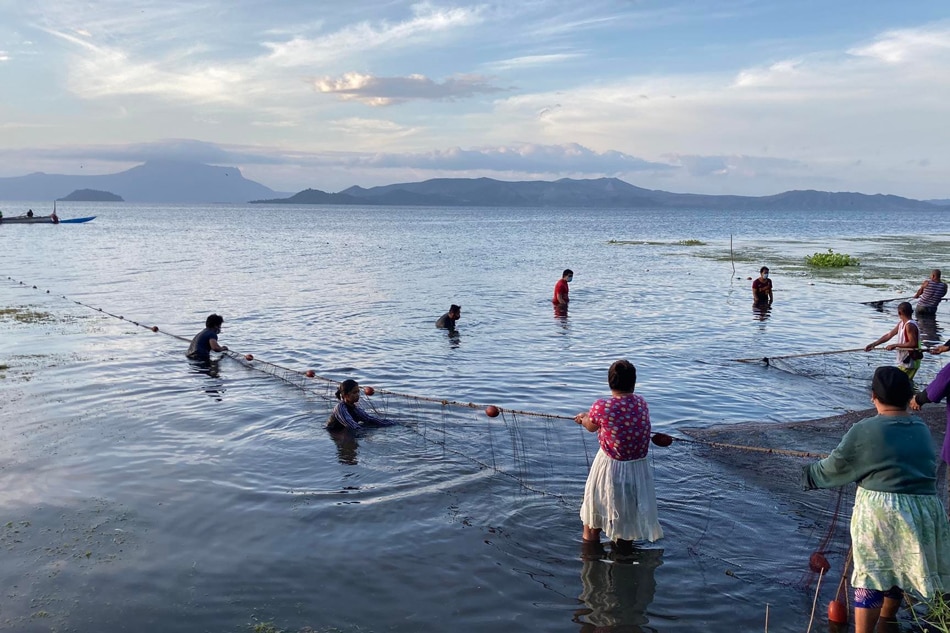MAYNILA— Ginagawan ng paraan ng ilang eksperto na maisalba ang endangered species na tawilis na papaubos na ang populasyon.
Sa pangunguna ni Dr. Ma. Vivian Camacho, station manager ng University of the Philippines Los Baños Limnological Station, kasama ang Department of Science and Technology Philippine Council for Agriculture, Aquatic, and Natural Resources Research and Development, may ilang pag-arangkada na sa mga inisyatibo para maparami uli ang endemic na isda sa Pilipinas.
Ayon kay Camacho, sinimulan nila ang proyekto matapos ang pag-aalboroto ng Bulkang Taal noong Enero 2020. Aniya, pangunahing nasira ang fish cages sa lugar dahil sa pag-aalboroto ng bulkan.
“The destruction was mainly on the fish cages, more on the tilapia and bangus culture because of the volcanic ash and the weight nung ash na ‘yung it actually destroyed most of the fish cages and caused a big loss in terms of kita nung fish cage culture,” kwento ni Camacho sa ABS-CBN News.
“They said na ‘yung tawilis just went underwater, they went deep into the waters of Taal lake and they tried to evade itong hash condition brought about by the Taal volcano explosion,” dagdag pa niya.
Paglilinaw ni Camacho na walang naging epekto ang pag-aalboroto ng Taal Volcano sa pagkamatay ng ilang tawilis, ngunit posible itong nakaapekto sa kalidad ng tubig sa lugar.
“There has been no record of tawilis kills or massive kills right after the Taal volcano explosion but I think mayroon itong effect in terms of … it actually deteriorated the water quality since ‘yung volcanic ash kapag nagcoat siya sa water it tends to decrease levels of dissolved oxygen,” saad ng station manager.
“‘Yung explosion na ‘to may lead to the extinction of our tawilis. So, in response to this we drafted a proposal, presented and this was implemented in June 2020 and ended in July this year,” aniya.
Ang tawilis ay endemic sa Taal Lake at ito lamang ang katangi-tanging freshwater sardine sa buong mundo na idineklarang endangered ng International Union for Conservation of Nature noong 2019.
“The catch of tawilis has been declining since 1998, from that year there have been observations of decline and in fact, they documented that the harvest of the species declined to about 50 percent in about 50 years,” ani Camacho.
Ayon sa eksperto, narito ang ilan sa mga dahilan kung bakit lumiit ang populasyon ng tawilis:
- overexplotation/overfishing
- paggamit ng illegal fishing gears
- pagbaba ng kalidad ng tahanan dahil sa polusyon
- aquaculture activities
- mismanagement ng fish feeds
- pagdami ng pinakikilalang fish species sa lugar
- polusyon sa mga industriya
- tourism activities
PAANO MAILILIGTAS ANG MGA TAWILIS?
Nagsusumikap ang UPLB Limnological Station at DOST para maisalba ang populasyon ng tawilis na tanging sa Pilipinas lang makikita.
Unang phase ng kanilang proyekto ay ang harvesting or collection, transport at initial rearing. Sa bahaging ito naging maingat ang mga mananaliksik na kumuha ng mga tawilis sa lugar sa komportableng temperatura at kalidad ng tubig na kanilang tinitirahan.
Anila, Sa 10 trial, sila ay naging matagumpay sa ika-7 na panatilihin silang buhay sa kanilang istasyon sa Mayondon, Los Baños, Laguna.
“The survivability was quite low, initially 10 percent lang ang survival and then we improved our methodology, we refined our protocols, ang pinakamataas na nakuha namin, na na-achieve na survival rate was 28 to 30 percent,” saad ng station manager.
“We only have a few individuals at the moment kasi we are experimenting… nag-e-experiment kami on how we can breed them in captivity using induced spawning. So, gumagamit kami ng hormones, we tried to inject them with hormones hoping that they can spawn in captivity but we lost several individuals by doing that. Actually, this is the first time being done. It’s actually exploratory, itong ginagawa experiment,” dagdag pa niya.
Sa ngayon, kinakailangan nina Camacho na kumuha pa ng mga tawilis sa Taal Lake para sa 2nd phase ng kanilang proyekto na captive breeding at larval rearing kung saan susubukan nilang paramihin ang naturang isda labas sa tahanan nito.
“‘Yun talaga ‘yung objective namin ‘yung paramihin sila, hindi lang ‘yung buhayin but of course ang endpoint nito is paramihin so that we can conserve them, dwindling na nga ‘yung population nila sa wild,” ani Camacho.
“And also we can develop it sa aquaculture backyard farming, aquaculture for fisherfolk as a source of livelihood,” dagdag pa niya.
Ayon kay Camacho, inaasahang tatagal nang 2 hanggang 4 taon ang 2nd phase ng proyekto at ilalaan naman sa phase 3 ang development growout techniques sa tawilis.
Sa ika-7 hanggang ika-10 taon naman ay posibleng isagawa ang pilot testing at pagpapakilala nito sa fisherfolk community at posibilidad na aquaculture nito, aniya.
Diin naman ng eksperto na nais nilang paramihin uli ang tawilis sa Taal Lake para makatulong sa kabuhayan ng mga mangingisda sa lugar.
“More importantly, after na paramihin sila, we also plan to stocking program or restocking program sa Taal Lake to further increase or enhance their population in the wild considering that their population is actually dwindling or decreasing for the past several years,” aniya.
“Tawilis is actually the dominant and the most important in terms of commercial importance in the open water fishery. This is a source of livelihood to several thousands of Taal Lake fisherfolk and source din ‘to sa mga distribution and marketing restaurants.”
(This article, written by Josiah Antonio, was first published in the ABSCBN Website on November 30, 2021)


